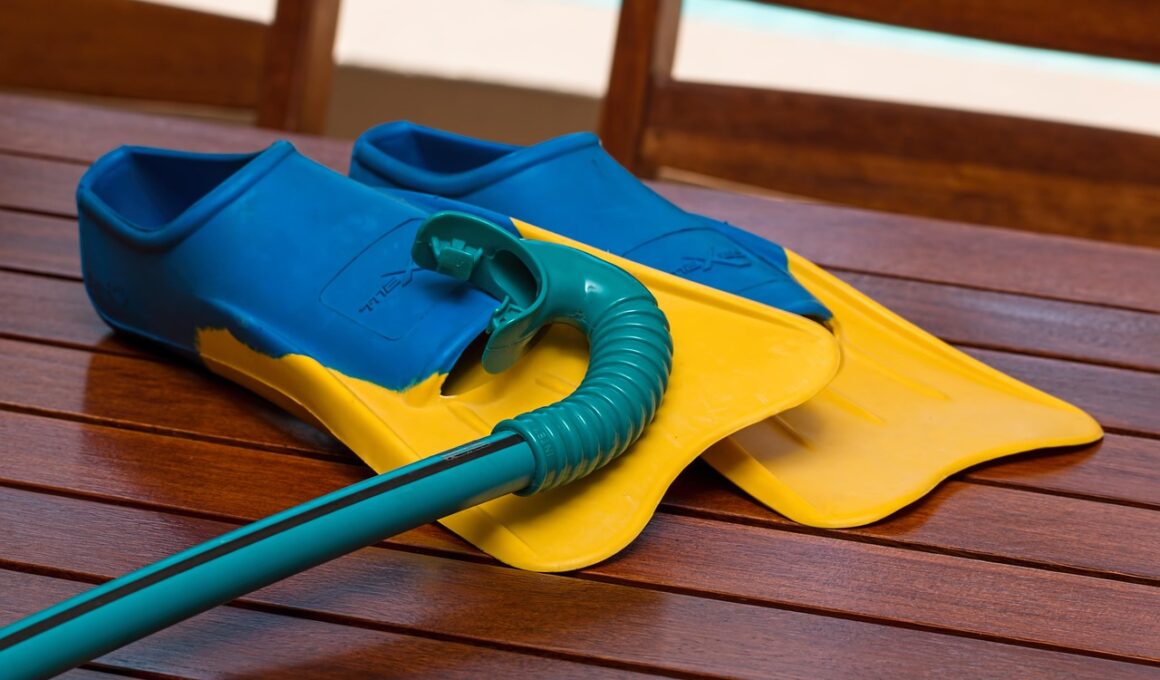Tracking Your Swimming Progress: Tips and Tools
Swimming is not just a refreshing pastime; it’s a fantastic way to enhance fitness and overall well-being. Keeping track of your swimming progress is essential for achieving your health goals. To effectively monitor your development, you can utilize different methods. A great way to start is by setting specific objectives, such as the number of laps, stroke technique, or time per distance. Consider utilizing a swimming app that allows you to log each session accurately. Many fitness-focused applications provide valuable insights and analysis of your swims, such as comparing your current performance to previous ones. You can also wear a waterproof smartwatch to track metrics like strokes per minute and lap times directly in the water. Establishing a routine helps maintain motivation, making progress tangible. Aim for consistence in your swimming sessions while gradually increasing intensity and duration. This approach ensures that your body adapts effectively. Regularly reviewing your stats will keep your motivation high by highlighting achievements and areas for improvement, ultimately guiding your journey to becoming a stronger swimmer.
Choosing the Right Tools for Tracking
Several tools can help streamline your progress tracking, making it engaging and informative. Consider using a waterproof notebook and pen, which can be useful for jotting down immediate observations after your sessions. Additionally, interval timers can aid in training sessions, allowing you to structure workouts effectively. Many swimmers have found great success with swimming-specific gadgets like swim watches or fitness trackers. Devices such as the Garmin Swim provide comprehensive metrics, including lap counting and stroke analysis, making them invaluable. Many of these gadgets sync with mobile apps to give you a broader overview of your swimming habits and performance. Another option is utilizing online platforms where swimmers share their progress, which can offer support and accountability. Forums or groups specifically geared towards swimmers can help you learn new tips or techniques while retaining awareness of your development. Furthermore, setting personal records within these platforms is a motivating factor. Engage with other swimmers to inspire each other and maintain commitment towards goals, as community support often amplifies individual progress while enjoying each other’s successes.
An excellent way to visualize your swimming journey is through regular reporting. This can be as simple as a weekly summary of your logged sessions. Maintaining a spreadsheet works well in documenting lap times, distances swum, and improvements made. Not only do the numbers provide insight into your capabilities, but graphing your progress can be exceptionally motivating. Create different charts to track various metrics, such as stroke efficiency over time or improvements in speed. You can also highlight goals for future sessions, giving you something concrete to work towards. Using visual representation of your data can present your progress in a digestible format, making your achievements apparent in a way that numbers alone cannot. Furthermore, sharing this visual data with fellow swimming enthusiasts can promote healthy competition, pushing you to strive harder. Another visualization technique includes before-and-after swim videos, allowing you to critically assess your form and technique. Gaining constructive feedback from peers can also make your swimming practice more beneficial. By combining technology with community resources, you can create a comprehensive and enjoyable tracking experience.
The Importance of Technique Evaluation
Another cornerstone of tracking swimming progress is evaluating your technique. Focus on refining your stroke mechanics to enhance efficiency, allowing you to swim faster with less effort. One way to do this is to record your swimming sessions or strokes and analyze the footage later. Several platforms enable video editing for breaks down every stroke. Consider seeking feedback from skilled swimmers or professionals to identify areas needing improvement. Observing various swimmers can also inspire new styles or strokes worth adopting. Utilize drills targeted at particular strokes to comprehend the distinct movements and body positioning required. Incorporate swimming drills into your training regimen to isolate weaknesses or improve upon strengths. Practicing with diverse techniques can break the monotony and invigorate your sessions. Additionally, examining your breathing patterns is crucial as it impacts pacing and endurance while swimming. Aim to establish a rhythm where breathing complements stroke patterns fluidly. Marrying performance tracking with coaching feedback ultimately leads to superior results, ensuring you consistently develop as a swimmer while cultivating a genuine appreciation for the sport.
Setting realistic, achievable objectives is vital in any swimming journey. Doing so not only makes tracking your progress easier but also fosters a sense of accomplishment over time. Start by cultivating short-term goals like swimming a specific number of laps or decreasing your time for a set distance. As you meet and exceed these initial targets, consider scaling your ambitions—transitioning your focus towards long-term goals, such as prepping for a competition or swimming a new distance. Regularly reevaluating your targets ensures they remain challenging yet attainable. Celebrate milestones, no matter how small; recognizing each achievement boosts morale and keeps you motivated on challenging days. Utilize your tracking tools to substantiate these accomplishments; seeing improvement documented can reinforce your dedication. Remember that progress in swimming, as in life, may not always be linear. Embrace days when you feel slower or less energized. They are essential to your journey; each swimmer experiences ups and downs. Keeping a positive mindset amidst these challenges allows you to stay focused and committed to the long-term vision of becoming a stronger or more competitive swimmer.
Community Engagement for Progress Tracking
Engaging with a swimming community can significantly enhance your motivation throughout your swimming journey. Connecting with others who share common goals fosters a support network that encourages accountability. You could consider joining online platforms or local clubs catering to swimmers of all ages and skill levels. Look for swim meet events, workshops, or training camps in your area or online. Natural competitors can help push you to reach your full potential. Additionally, sharing your journey and documenting progress on social platforms provides another layer of support and motivation. Popular platforms like Instagram and Facebook feature numerous swimming groups with members sharing tips, experiences, and personal progress updates. Daily interactions can foster friendships with fellow enthusiasts, transforming a solitary sport into a collaborative journey. Later, invite friends to join you for swimming sessions, raising the fun factor within your workouts. The benefits of socializing extend to accountability; discussing goals ensures commitment to meeting them and learning from the shared experience. Ultimately, community involvement creates a vibrant swimming culture that nurtures growth for everyone involved.
Lastly, adopting a flexible mindset towards tracking your swimming progress is crucial for sustained motivation and enjoyment. Individual lifestyles and circumstances may affect paces and availability, which is perfectly okay. Instead of fixating solely on quantitative outcomes, cherish qualitative aspects related to swimming. Focus on how you feel in the water, the stress relief it provides, and how it contributes to your overall fitness. Occasionally assess your mindset while swimming; are you pushing limits or looking for enjoyment? It’s imperative to maintain passion without transforming the activity into a chore. Be open to adapting techniques; explore new strokes or drills that excite you within the sport. Identify joy in small victories outside of numbers; appreciating refined techniques or achieved personal bests without an overarching obsession with metrics contributes to a fulfilling swimming experience. The key is balance; maintain structure while allowing for some freedom and spontaneity in your sessions. Cultivating this mindset allows you to align swimming goals constructively with personal desires, ensuring your growth, happiness, and commitment to continuing your progress over time.
Swimming is a marvelous fusion of relaxation, exercise, and personal challenge, offering an inviting way to engage both body and mind. Keeping track of your swimming progress is important for enhancing fitness levels and accountability. One great starting point is to establish pertinent goals, including the number of laps, swim strokes, and workout frequency. Committing to specific metrics allows you to visualize progress, ensuring that each swimming session benefits your fitness journey. Consider downloading a swimming app that tracks sessions—these apps often feature both logging and analytic tools. They can provide insights comparing your current performance to past achievements. You’ll find wearables, like waterproof fitness trackers, extremely valuable as they document metrics while swimming. Focus on consistent practice, gradually increasing distances and durations to help your body adjust effectively to the demands of the sport. In addition to tracking, reviewing your progress after sessions is essential since it will keep you motivated to go further. Progress might appear gradual at times, but focusing on the details of your improvement can make a world of difference, ultimately leading to increased efficiency in the water.


